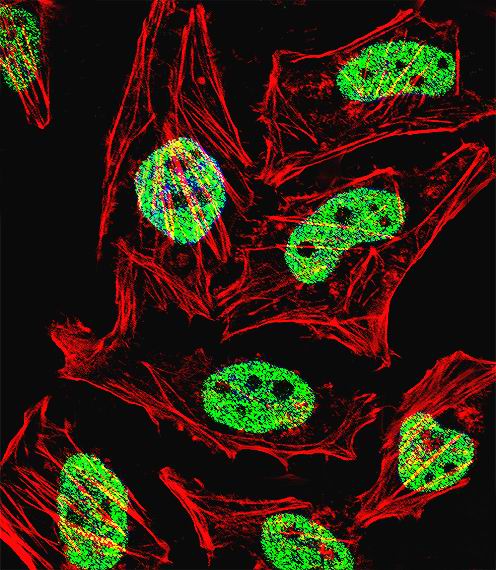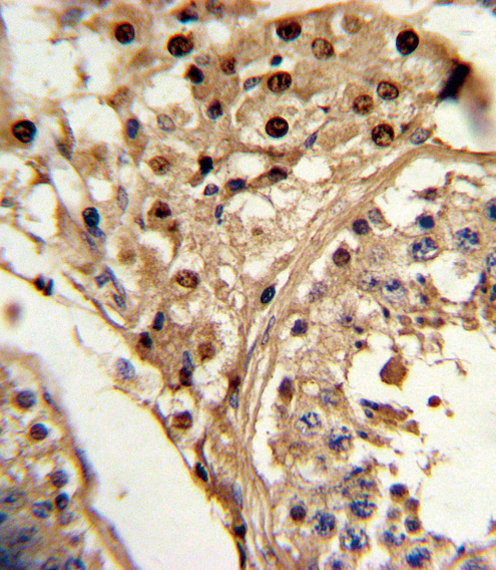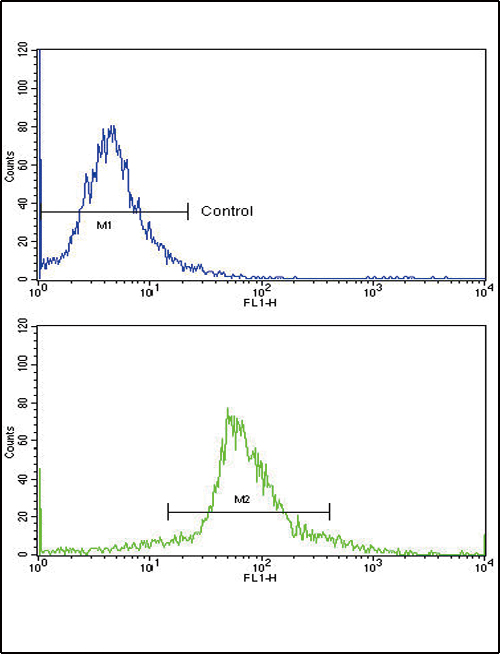KLF6 Antibody (C-term)
Purified Rabbit Polyclonal Antibody (Pab)
- SPECIFICATION
- CITATIONS: 2
- PROTOCOLS
- BACKGROUND

Application
| WB, IF, IHC-P, FC, E |
|---|---|
| Primary Accession | Q99612 |
| Reactivity | Human, Mouse |
| Host | Rabbit |
| Clonality | Polyclonal |
| Isotype | Rabbit IgG |
| Calculated MW | 31865 Da |
| Antigen Region | 159-186 aa |
| Gene ID | 1316 |
|---|---|
| Other Names | Krueppel-like factor 6, B-cell-derived protein 1, Core promoter element-binding protein, GC-rich sites-binding factor GBF, Proto-oncogene BCD1, Suppressor of tumorigenicity 12 protein, Transcription factor Zf9, KLF6, BCD1, COPEB, CPBP, ST12 |
| Target/Specificity | This KLF6 antibody is generated from rabbits immunized with a KLH conjugated synthetic peptide between 159-186 amino acids from the C-terminal region of human KLF6. |
| Dilution | WB~~1:1000 IF~~1:10~50 IHC-P~~1:10~50 FC~~1:10~50 E~~Use at an assay dependent concentration. |
| Format | Purified polyclonal antibody supplied in PBS with 0.09% (W/V) sodium azide. This antibody is prepared by Saturated Ammonium Sulfate (SAS) precipitation followed by dialysis against PBS. |
| Storage | Maintain refrigerated at 2-8°C for up to 2 weeks. For long term storage store at -20°C in small aliquots to prevent freeze-thaw cycles. |
| Precautions | KLF6 Antibody (C-term) is for research use only and not for use in diagnostic or therapeutic procedures. |
| Name | KLF6 |
|---|---|
| Synonyms | BCD1, COPEB, CPBP, ST12 |
| Function | Transcriptional activator (By similarity). Binds a GC box motif. Could play a role in B-cell growth and development. |
| Cellular Location | Nucleus. |
| Tissue Location | Highly expressed in placenta followed by spleen, thymus, prostate, testis, small intestine and colon. Weakly expressed in pancreas, lung, liver, heart and skeletal muscle. Also expressed in fetal brain, spleen and thymus |

Provided below are standard protocols that you may find useful for product applications.
Background
COPEB is a member of the Kruppel-like family of transcription factors. The zinc finger protein is a transcriptional activator, and functions as a tumor suppressor.
References
Sangodkar,J., Eur. J. Cancer 45 (4), 666-676 (2009) DiFeo,A., Drug Resist. Updat. 12 (1-2), 1-7 (2009)
If you have used an Abcepta product and would like to share how it has performed, please click on the "Submit Review" button and provide the requested information. Our staff will examine and post your review and contact you if needed.
If you have any additional inquiries please email technical services at tech@abcepta.com.














 Foundational characteristics of cancer include proliferation, angiogenesis, migration, evasion of apoptosis, and cellular immortality. Find key markers for these cellular processes and antibodies to detect them.
Foundational characteristics of cancer include proliferation, angiogenesis, migration, evasion of apoptosis, and cellular immortality. Find key markers for these cellular processes and antibodies to detect them. The SUMOplot™ Analysis Program predicts and scores sumoylation sites in your protein. SUMOylation is a post-translational modification involved in various cellular processes, such as nuclear-cytosolic transport, transcriptional regulation, apoptosis, protein stability, response to stress, and progression through the cell cycle.
The SUMOplot™ Analysis Program predicts and scores sumoylation sites in your protein. SUMOylation is a post-translational modification involved in various cellular processes, such as nuclear-cytosolic transport, transcriptional regulation, apoptosis, protein stability, response to stress, and progression through the cell cycle. The Autophagy Receptor Motif Plotter predicts and scores autophagy receptor binding sites in your protein. Identifying proteins connected to this pathway is critical to understanding the role of autophagy in physiological as well as pathological processes such as development, differentiation, neurodegenerative diseases, stress, infection, and cancer.
The Autophagy Receptor Motif Plotter predicts and scores autophagy receptor binding sites in your protein. Identifying proteins connected to this pathway is critical to understanding the role of autophagy in physiological as well as pathological processes such as development, differentiation, neurodegenerative diseases, stress, infection, and cancer.




